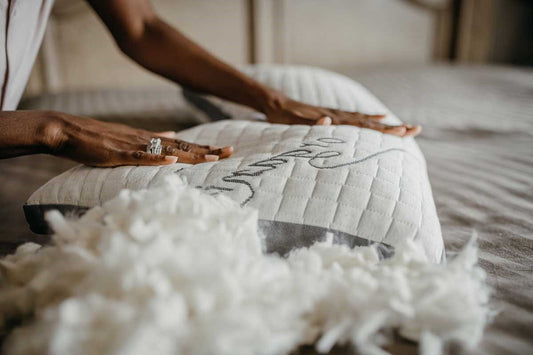When it comes to pillows for a person, their personal needs trump all! In general, the focus is on materials that are hypoallergenic, resistant to dust mites, mold, and other allergens, while still providing comfort and support. Here’s a breakdown of the best types of health conscious pillows for an individuals specific needs:
1. Latex Pillows
- Why They're Great: Natural latex is naturally resistant to dust mites, mold, and mildew. It's also hypoallergenic, making it a popular choice for people with allergies. Latex pillows provide excellent support, are breathable, and help maintain a cooler sleeping surface.
- Additional Benefits: Latex is durable and holds its shape well over time, making it a good long-term investment.
- Cons: Can be firm for some sleepers, more expensive than synthetic options, and may have a rubbery smell at first (though it dissipates with use).
2. Memory Foam Pillows (Hypoallergenic Versions)
- Why They're Great: Memory foam pillows, especially those made from higher-quality hypoallergenic foam, are naturally resistant to dust mites and allergens. They contour to the shape of your head and neck, providing excellent support.
- Gel-Infused Options: Some memory foam pillows are infused with cooling gels to help regulate temperature, adding to their comfort for allergy sufferers who may struggle with overheating.
- Cons: Can trap heat (unless gel-infused), has an initial off-gassing odor, not machine-washable, may feel too dense for some users.
3. Down Alternative Pillows
- Why They're Great: For people who love the softness of down but have allergies to feathers, down alternative pillows are a fantastic solution. These pillows are made from synthetic fibers that mimic the softness of natural down but are hypoallergenic and resistant to dust mites.
- Variety: These pillows come in a range of firmness levels and are typically more affordable than natural down.
- Cons: Tends to flatten over time, less durable than natural down or memory foam, requires frequent fluffing.
4. Bamboo Pillows
- Why They're Great: Bamboo pillows are made from shredded memory foam or other materials encased in a bamboo fabric cover. Bamboo is naturally hypoallergenic and resistant to dust mites, mold, and bacteria. It also wicks away moisture and is highly breathable, making it a great choice for those who tend to overheat during sleep.
- Eco-Friendly: Many bamboo pillows are eco-friendly, adding an extra layer of appeal for those who are environmentally conscious.
- Cons: Some models can be too firm or too soft depending on the fill (shredded memory foam, for example), can be pricey compared to cotton pillows.
5. Anti-Allergy Pillows (Treated Fabrics)
- Why They're Great: Some pillows are specifically designed for allergy sufferers, using treated materials that repel dust mites, bacteria, and mold. These anti-allergy pillows often have tightly woven covers that create a barrier against allergens.
- Additional Benefits: These pillows can be made from a variety of materials (like microfiber or memory foam) but have the added benefit of built-in protection, reducing the need for additional pillow protectors.
- Cons: Some treated pillows may lose effectiveness over time, can have a chemical odor initially, and may not be as comfortable as non-treated pillows.
6. Organic Cotton Pillows
- Why They're Great: Organic cotton pillows are an excellent option for allergy sufferers as they are free from synthetic chemicals and pesticides that could trigger allergic reactions. Cotton is breathable and naturally resistant to dust mites, and when grown organically, it’s a healthier option for people with sensitive skin or respiratory allergies.
- Maintenance: These pillows often need more frequent washing to maintain cleanliness, but they offer a natural and eco-friendly option.
- Cons: Can flatten over time, less supportive compared to memory foam or latex, may require more frequent washing, and may not be suitable for those who need firmer pillows.
7. Wool Pillows
- Why They're Great: Wool pillows are naturally hypoallergenic, resistant to dust mites, and mold. Wool is also excellent at regulating temperature, keeping sleepers cool in summer and warm in winter. Its moisture-wicking properties further enhance its benefits for allergy sufferers by reducing the dampness that can attract dust mites.
- Natural Benefits: Wool is also renewable and eco-friendly, making it a good choice for sustainability-conscious consumers.
- Cons: Can be firmer than other types, heavier, more expensive, and may require fluffing to maintain shape over time.
8. Kapok Pillows
- Why They're Great: Kapok fiber, harvested from the seed pods of kapok trees, is a natural and hypoallergenic filling option. These pillows are lightweight, soft, and resistant to dust mites. Kapok is also sustainably harvested, adding to its appeal for eco-friendly shoppers.
- Feel: Kapok pillows are fluffy like down pillows but without the allergy risk that comes with feathers.
- Cons: Can be too soft for some people, not as supportive as latex or memory foam, and may flatten over time, requiring fluffing.
9. Buckwheat Pillows
- Why They're Great: Buckwheat pillows are filled with hulls from buckwheat seeds. The hulls create a firm, supportive pillow that molds to the shape of your head and neck. Buckwheat hulls are naturally hypoallergenic and do not harbor dust mites or other allergens.
- Breathability: These pillows are also highly breathable, helping to maintain a cooler sleep environment, which can be beneficial for people with allergies or asthma.
- Cons: Can be noisy due to the hulls shifting, firm and heavy, may take time to get used to, and not suitable for those who prefer soft pillows.
10. Silk Pillows
- Why They're Great: Silk is a luxurious option that’s naturally hypoallergenic and resistant to dust mites and mold. Silk pillowcases and pillows are also gentle on the skin, making them a great choice for people with sensitive skin or those prone to acne.
- Beauty Benefits: In addition to their hypoallergenic properties, silk pillows are popular for reducing friction on the skin and hair, which can help prevent wrinkles and hair breakage.
- Cons: Expensive compared to other options, delicate and may require special washing (like hand-washing or dry cleaning), and less supportive than foam or latex pillows.
Additional Tips for Allergy Sufferers:
- Use Pillow Protectors: Even with hypoallergenic pillows, it's a good idea to use zippered pillow protectors. These covers provide an extra barrier against dust mites, mold, and other allergens.
- Wash Pillows Regularly: Make sure to wash pillows (if washable) or air them out frequently to reduce the buildup of dust mites and allergens. Some pillows, like memory foam, are not machine washable, so spot-cleaning or using washable covers is essential.
- Replace Pillows Regularly: Even the best hypoallergenic pillows should be replaced every 1-2 years to ensure they remain allergen-free and provide proper support.
For those seeking the ultimate pillow solution for allergy relief, Sleep Artisan’s Talalay Latex pillows are an excellent option. Made from natural Talalay latex, these pillows are hypoallergenic, resistant to dust mites, mold, and other allergens, making them ideal for sensitive sleepers. Talalay latex is also known for its breathability, keeping your pillow cool throughout the night, while providing optimal support for your head and neck. Unlike synthetic materials, Sleep Artisan uses eco-friendly latex, free from harmful chemicals, ensuring a healthy and comfortable sleep environment. Plus, with its customizable design, you can adjust the fill to suit your personal comfort preferences, putting your needs first.





